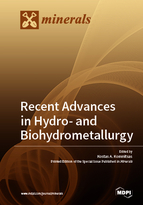Recent Advances in Hydro- and Biohydrometallurgy
A special issue of Minerals (ISSN 2075-163X). This special issue belongs to the section "Mineral Processing and Extractive Metallurgy".
Deadline for manuscript submissions: closed (31 March 2019) | Viewed by 64875
Special Issue Editor
Interests: mineral processing; grinding; hydrometallurgy; waste valorization
Special Issues, Collections and Topics in MDPI journals
Special Issue Information
Dear Colleagues,
Hydro- and biohydrometallurgical processes have been used for years to solve bottlenecks in the raw materials supply, and to provide environmental solutions for various industrial problems. This Special Issue aims to present recent technological advances and innovative solutions towards unlocking the use of potential raw materials—both primary and secondary—as potential metal resources. Emphasis is placed (among others) on the treatment of economically important deposits, refractory ores, low-grade polymetallic wastes, sludges (e.g., goethite, jarosite), slags, and electronic waste which are currently not yet being fully exploited due to technical problems. In addition, the extraction of critical elements and REEs through leaching or bio-leaching (including heap (bio)leaching studies) as well as the biodesulfurization of coals is of particular importance. Developmets on the recovery of metals from dilute and concentrated solutions should be highlighted. Studies on kinetics, process medeling, reactor design, and life cycle analysis are also welcome. The contribution of hydro- and biohydrometallurgy towards circular economy and the zero-waste approach should also be emphasized. Special attention is paid to the validation of hydro- and biohydrometallurgical systems. Socio-economic aspects related to all pertinent applications of hydro- and biohydrometallyrgy may also be addressed. Finally, contributions pertinent to advances in solvometallurgy are also well accepted.
Prof. Dr. Konstantinos Komnitsas
Guest Editor
Manuscript Submission Information
Manuscripts should be submitted online at www.mdpi.com by registering and logging in to this website. Once you are registered, click here to go to the submission form. Manuscripts can be submitted until the deadline. All submissions that pass pre-check are peer-reviewed. Accepted papers will be published continuously in the journal (as soon as accepted) and will be listed together on the special issue website. Research articles, review articles as well as short communications are invited. For planned papers, a title and short abstract (about 100 words) can be sent to the Editorial Office for announcement on this website.
Submitted manuscripts should not have been published previously, nor be under consideration for publication elsewhere (except conference proceedings papers). All manuscripts are thoroughly refereed through a single-blind peer-review process. A guide for authors and other relevant information for submission of manuscripts is available on the Instructions for Authors page. Minerals is an international peer-reviewed open access monthly journal published by MDPI.
Please visit the Instructions for Authors page before submitting a manuscript. The Article Processing Charge (APC) for publication in this open access journal is 2400 CHF (Swiss Francs). Submitted papers should be well formatted and use good English. Authors may use MDPI's English editing service prior to publication or during author revisions.
Keywords
- hydro- and biohydrometallurgy
- leaching
- raw materials
- residues
- slags
- critical elements
- REEs
- life cycle analysis






